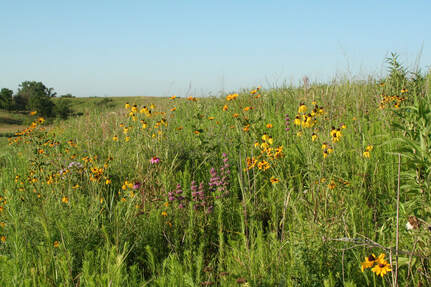The Bee & Butterfly Habitat Fund identifies opportunities to establish critical pollinator habitat to help honey bee and monarch butterfly populations thrive. Guided by the mission to increase and improve pollinator forage and habitat, the organization develops affordable, pollinator-focused seed mixes through NextGen Habitat Projects.
Learn More:
Why is habitat important?
Critical habitat is disappearing in the United States. As a result, honey bees and other pollinators like monarch butterflies are in serious decline. These pollinators are essential to life as we know it. In fact, about one-third of global food production and billions in agriculture are dependent on pollinators to some degree – honey bees and other insects pollinate 80 percent of flowering plants worldwide. In addition, honey bees are vital to agriculture and pollinate most of the fruit and vegetable crops humans (and that’s not considering the impact on livestock!) consume every day – 90 different crops, making up 1/3 of our food supply!
How did the program develop?
In response to the long-term, continued loss of high-quality, nutritious forage for honey bees and critical habit for monarch butterflies, The Bee & Butterfly Habitat Fund was formed in 2017. A pilot program was opened to landowners in North and South Dakota. The program was intended to demonstrate how critical habitat could be developed by identifying NextGen Habitat Projects – those areas where habitat can make a measurable difference for pollinators. Results indicate that creating critical habitat can be cost-effective and highly diverse while producing outstanding results for multiple beneficiaries.
How is the Bee and Butterfly Habitat Fund different from other organizations?
The Bee & Butterfly Habitat Fund brings together landowners, conservationists, scientists, and beekeepers to precisely target pollinators’ needs like never before. Using funds donated by generous corporate sponsors and individual donors, the team works together to build healthy, sustainable pollinator habitat through science-based, proven results. The Bee & Butterfly Habitat Fund has created a diverse mix of grasses and flowers that help provide the ideal habitat for pollinators and wildlife – bees, butterflies, grassland songbirds, pheasant, quail, upland birds and more.
In addition, the NextGen Habitat Projects are differentiated from other programs by:
In addition, the NextGen Habitat Projects are differentiated from other programs by:
- Precision seed mixtures that deliver maximum benefits for pollinators
- Cost-effective plantings, designed to maximize both quality and quantity
- Superior ability to manage early weed competition
- Streamlined non-government enrollment and adaptability for landowners
- Maximum value per acre, optimizing bloom diversity and abundance throughout the growing season
- Two separate plantings on each project ensure success for multiple species
- Opportunity for beekeepers to work with landowners to improve forage near their hives
- Better establishment and management flexibility






